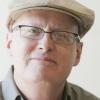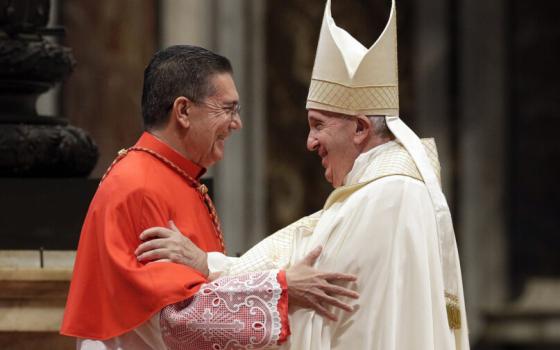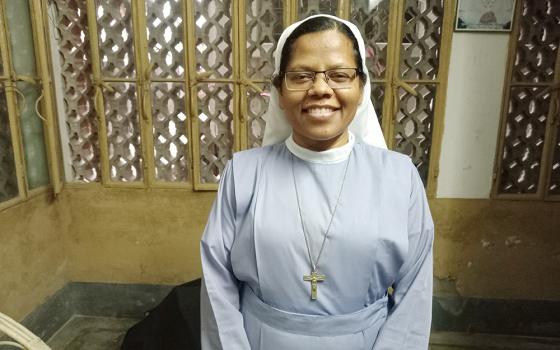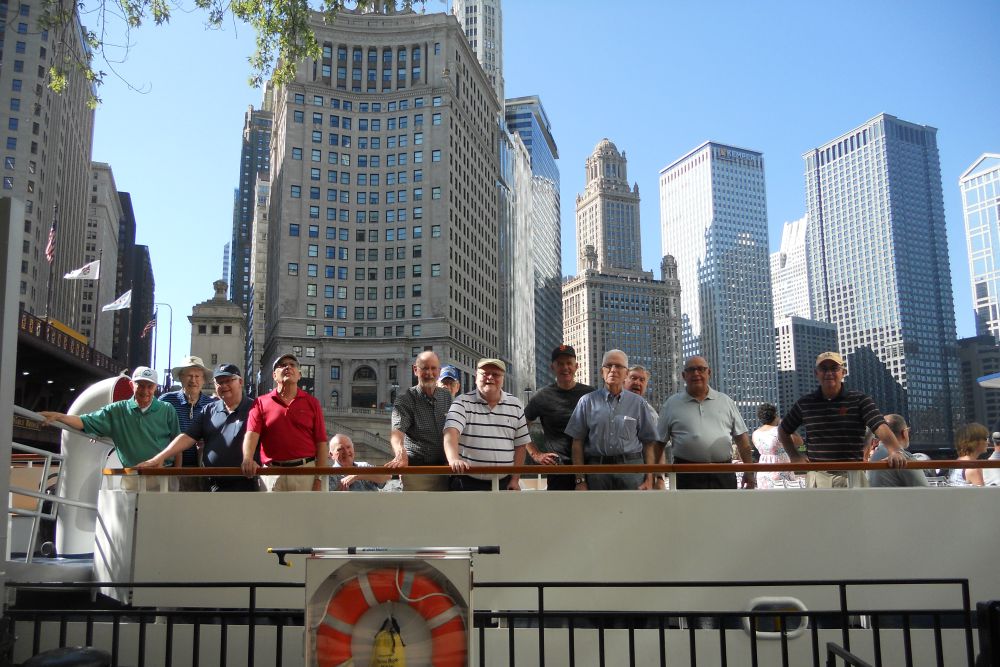
George Thompson, Don Klein, Joe McCool, Bob Livingston, Phil Gallagher, John Schultz, Frank Glynn, Dick Marx, Rich Laveroni, Joe Reid, Larry Purcell, Pete Buchagnani and Jim Purcell line the railing of the Wendella for a boat trip on the Chicago River and Lake Michigan with the Chicago skyline in the background. (Ken Trainor)*
Editor's note: Sept. 22, 1962, 70 seminarians chosen from around the U.S. set off for Rome to live at the North American College overlooking St. Peter's Basilica and to study for their licentiate degrees in sacred theology at the Pontifical Gregorian University. This particular group had the luck to be there just as the Second Vatican Council was getting underway. The experience was transformative.
The class reconvened in Chicago in September, 52 years after they were ordained on a chilly December day in St. Peter's Basilica, 10 days after the close of the Second Vatican Council. Only 20 members gathered this time, but the numbers don't matter. If two or more are gathered in the name of Rome and John XXIII and Vatican II, the Spirit is there — because they like each other, because they aren't getting any younger, and because they shared a powerful experience.
On first glance, you might mistake them for just a bunch of old, white guys, but that's not all they are.
They're also a finger pointing at the moon. The same moon Pope John XXIII pointed to on that magical evening as he spoke to assembled Romans and visitors in St. Peter's Square following the opening session of Vatican II on Oct. 11, 1962. "Even the moon has rushed to join us with its beautiful light," he told the crowd beneath his open window.
The "Council Class," as they call themselves, 70 strong from all over the United States, had arrived in Rome 10 days earlier, following their voyage on the SS Leonardo da Vinci. They were thrown together and remained together for four years. They couldn't go home. Even phone calls were rare back then. Under normal circumstances, the resulting bond would have been strong. Toss in an ecumenical council, for which they had a ringside seat, and you have the makings of a life-altering experience.
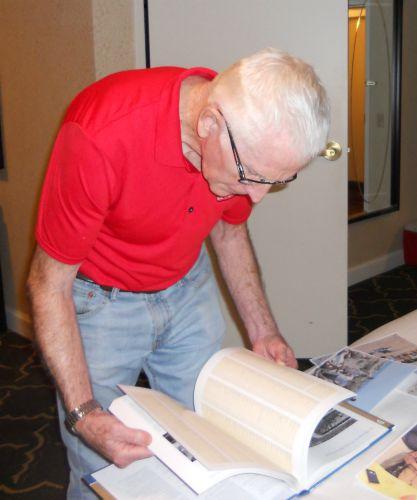
Joe Reid pores over memorabilia from the North American College class of 1966. (Ken Trainor)
"It started on the boat from New York to Italy," recalled Jim Purcell, who had traveled cross-country just to board that boat. "Whoever decided that's how the class should begin to get to know itself was a genius. We just took over our part of the boat, and that's where it all began."
Fifty-five were eventually ordained. Sixteen are still active priests. Thirty-one left the active priesthood.
They came home aflame — and ran headlong into the mid-1960s. The turbulence of change was fierce, but so was their zeal. Something had to give. For many, it was the priesthood. Most thought, in the wake of Vatican II, that mandatory celibacy would soon become optional. They were wrong. They thought the ban on contraception would be overturned. They were wrong. As some joined the first great wave of resignation, laicization or whatever term you choose, they feared their fellow Council Class members would ostracize and reject them.
They were wrong.
Many forged new paths, establishing careers — frequently pastoral in nature — getting married, raising kids. Keeping tabs on one another wasn't as easy then as it is today. There was no internet yet, no email.
But they had Bill Freburger, who left the priesthood in 1976 and worked for NCR. He created a mailing list and shared memoirs of their time in Rome with his classmates. In 1997, he died too young, but his efforts led to their first reunion, which took place in Chicago in 1991, the 25th anniversary of ordination.
Advertisement
They continue to share something else: mutual respect and acceptance. You could see it as they gathered in the Gilded Age-splendor of the Palmer House Hotel lobby, and later during a reception hosted by John Schultz and Dick Marx. Some wicked wit surfaced as they perused photo albums spread open on the bed, collectively piecing together a memory mosaic, aided by Schultz's slide show, which began with a picture of John XXIII, followed by Pete Buchagnani performing a cannonball in the pool at The Villa, North American College's summer retreat house in Tuscany.
"Is that the Monsignor?" someone called out. Yes indeed, and when the monsignor arrived shortly thereafter, Rich Laveroni got down on one knee, bidding a solemn welcome to "Your Excellency."
"Both knees, please," Pete deadpanned.
The wisecracks never stopped. When Bob Faherty announced the schedule for the next two days, including a boat cruise on Lake Michigan and the Chicago River, Joe McCool asked, "Shall we gather at the river?"
Updates were exchanged, often about the illnesses that come with age among those not in attendance.
Why do they keep getting together? As Frank Glynn observed, "You see these old, wrinkled guys walk in and immediately the veil goes away. After 10 minutes, there's that young guy you spent time with. We had such wonderful camaraderie and a total experience together that you want to go back and get another piece of it."
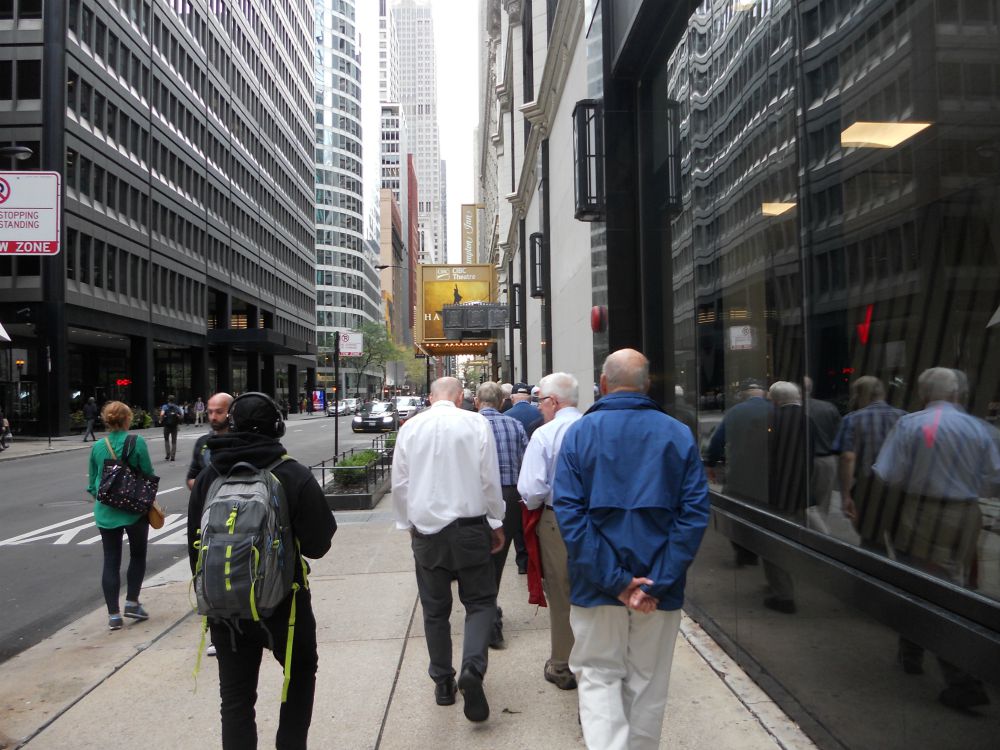
Pilgrims' progress: "Council Class" members walk to St. Peter's Church in Chicago's Loop for Mass. (Ken Trainor)
An article shared by Joe Reid about the old theological notion that an "ontological change" occurs through ordination became a running gag throughout the four days here. The class never bought that, had great fun with it, and gave it a serious thrashing.
Vic Clore, for instance, grew up on a farm in Michigan, and they couldn't keep him down on it after he'd seen Rome. Neither could they pry him out of his inner-city Detroit parish, Christ the King, where he has spent his entire ministry. As he prepared to send in his retirement letter at the age of 75, the archdiocese not only asked him to stay on but added a second parish. Fortunately, Clore said, he has been "encouraging lay leadership for years." Lay empowerment is the blueprint of the church's future, he added:
Pope Francis' call to break the back of clericalism — he's got his finger on the right thing there if he can get that message across to enough bishops to realize that this is not an elevated, ontologically superior state. … I think why many bishops got in trouble [with the sex abuse scandal] was because they believed priests are ontologically superior and can't do anything this bad, so they weren't really taking it seriously. … I do think that will be the major challenge of the next several years, to break this clericalism and think of ways of transforming the sacrament of orders into a living kind of leadership sacrament that anybody in the church would be eligible to be appointed to, obviously with preparation and some kind of spiritual grounding.
The following morning, they did indeed gather at the river below the Wrigley Building, to catch the 10:15 Wendella boat ride on a hot but clear late-summer morning.
Because they first met on a boat, these trips have become something of a tradition for the Council Class — and a metaphor. "We were all in the same boat," Don Klein likes to say. "We still are."
Which may be why, at Mass the following day, held at St. Peter's, a Franciscan church in the Loop, they chose St. Luke's Gospel (5:1-11) in which Jesus tells the apostles to cast their nets on the other side of the boat.

St. Peter's Franciscan Church in the Loop. (Ken Trainor)
Klein began the liturgy in the Friary Chapel saying, "Fifty-six years ago, Sept. 22, 1962, we all got on a boat. We've been on that boat a long time. It's been a good ride. So we begin …"
Bill Burke expanded on that motif in his homily:
You know the story. We've heard it many times — "Leave me, Lord, for I am a sinful man." Not only because Peter is a symbol of the church at large, but also a symbol of all of us. Many a time the Lord has had to preach to people from "our boat," feeble as it may have been, near to sinking as it was at times. I thought, the Lord's love is just so incredible. It's as if it didn't matter what Peter said.
"Don't worry about that. Peace be with you. Don't be afraid. From now on you're going to catch people."
It's the mission. Jesus wanted to reach as many people as possible. He knew he had very little time because the message was threatening to the powers. So the fact that Peter acknowledged his sinfulness, that's fine. The psalms are full of that. But more important was, "I need you, Peter, I need you." Of course, he risked betrayal because whenever you love you risk betrayal. He did it anyway. He loved this man anyway. …
I'm so grateful that I saw this reading because it touched me. I can't wait around either and lament and mourn what happened in Pennsylvania or Boston or here in Chicago. The Lord wants me to do what I can with the years I have left. And that means tending these lambs and these sheep. His mission.
In 2013, I published a book on the Council Class, Unfinished Pentecost: Vatican II and the Altered Lives of Those Who Witnessed It, just as a new pope came into view. This time around, the obvious question for discussion, 52 years after Rome and five years after the election of Pope Francis, is this: Has Francis made a difference in your view of Vatican II and your hopes for the future of the Catholic church?
The class had plenty to say:
"The Vatican Council gave a whole new vision of possibility for the Catholic church," said Bob Livingston of Detroit, who left the active priesthood, married and, had a long career with General Motors. "That was personally transformative. It was the most exhilarating intellectual and faithful thing I have ever experienced. When Francis came in, it was like going back to 1966. It was like coming out of a long, dark tunnel. Francis was like stepping back into John XXIII, a breath of fresh air.
"In Pope Francis, the Holy Spirit is alive and well," noted John Schultz, still an active priest as a hospital chaplain in Eau Claire and Chippewa, Wisconsin. "Francis reminds me of John XXIII, the gutsy decisions. John had a lot of them, Francis even more so. I am so happy and so pleased that he is at the helm. ... How long can he hang in there? I don't know, but I like the way the Holy Spirit and he are working together."
Jim Purcell, who left the active priesthood in 1972 and who has just become chair of the NCR board of directors, said that when Francis became pope, "I was elated — the fact that he was from Latin America, that we were getting someone who had at least been exposed to liberation theology, that he would have a perspective of global Catholicism that was not primarily European. I felt like the retrenchment that had taken place under John Paul II and under Benedict had a chance of being turned around. And that has proven true in his encyclicals and exhortations and his appointment of bishops in the U.S."
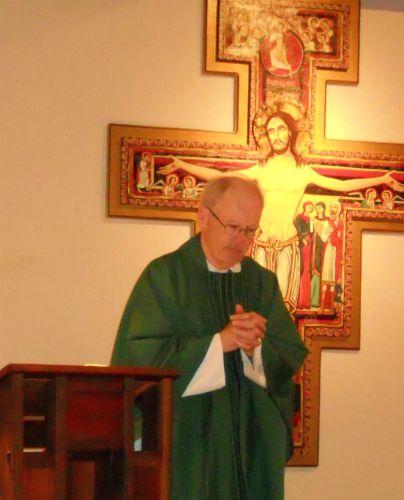
Don Klein begins Mass in St. Peter's Friary Chapel. (Ken Trainor)
He has concerns — "The one thing he still doesn't get is women in the church" — but remains hopeful.
Frank Glynn of Virginia Beach, Virginia, is the only attendee at this reunion who was not ordained. He spent his career in military intelligence, much of it stationed in Rome.
"Francis," he said, "is a leap forward. "Late in John Paul II's time and even during Benedict's time, we started to circle the wagons. We were against the world. You could tell right from the start that Francis had a totally different look at things. It's our duty to be in the world, to be another Christ in the world."
Joe McCool, married with two sons, left the priesthood in the 1970s but remains an active priest in his own way with an intentional worship community called Emmaus. He has a marriage and family therapy practice in the Boston area.
"Francis has been a very positive force," he said, "but I'm sure he's suffering a lot from the reaction of those who are of the Ottaviani school of Semper Idem, 'always the same.' They'd rather have him out of there because he's making too many changes.
"He's not a one-man show. He's not the king. I see his role as being more prophetic. His personality is open. But I hope he's not involved in the sex abuse cover-up. I can't believe it. It doesn't fit with him."
On Thursday evening, the group occupied a long table down the center of the Italian Village restaurant. One diner from a separate party couldn't contain her curiosity and came by to ask who they were. McCool gave her the short version — a reunion of the North American college class of 1966 from Rome. But there's no easy answer to that question.
Who are they? Unusual in the church. They witnessed a contested — deeply celebrated and deeply resisted — sea change in one of the most influential mainstream religious denominations of the world: a church council whose influence is just beginning to be felt.
Most of the immediate council participants have died, leaving this group of eye- and ear-witnesses to communicate what it is that Catholics can't afford to forget about what happened once upon a time in Rome. They are a microcosm of the church in the modern world, a repository of living memory. And they won't be around forever.
Most of all, they are, as Jim Murphy put it, by way of Thomas Merton, a finger pointing at the moon — in all its phases, including its exhilarating fullness, even when obscured. These classmates would say, "Don't pay attention to us. Pay attention to what we're pointing at," and the moon they're pointing at is the Second Vatican Council, reflecting the light of that major eruption of the Holy Spirit, a moon capable, in its fullness, of lighting our way forward into the future.
But that's probably a little more than our fellow diner was expecting.
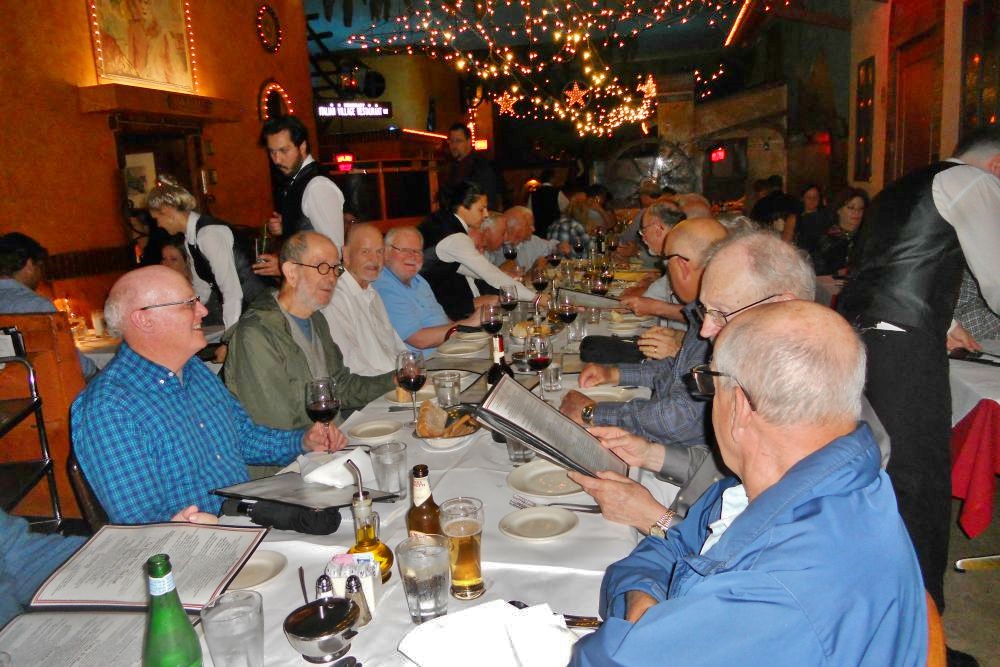
The "Council Class" at dinner at Italian Village (Ken Trainor)
[Ken Trainor is a lifelong, "free-range" Catholic who spent seven and a half years immediately following Vatican II in the Chicago Archdiocesan seminary system. He left the seminary to study in Rome then completed his B.A. in literature at Loyola University of Chicago, later earning a master’s degree in creative writing from Colorado State University. He has been a community journalist and newspaper editor in Oak Park, Illinois, for the past 28 years and is the author of We Dare to Say: An Adventure in Journaling (ACTA, 2007) and Unfinished Pentecost: Vatican II and the Altered Lives of Those Who Witnessed It (ACTA 2013).]
* An earlier version of this story provided the wrong last name for George Thompson in the photo cutline.
